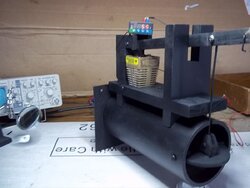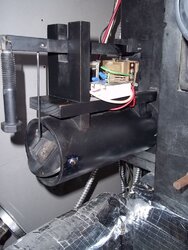Here's a question for the Wood Gun guys, but it would also be interesting to hear from folks with other boiler makes (those having storage will probably not know anything about this  ). The WG is apparently able to stifle combustion in the firebox very effectively, by cutting off air flow. Don't know if it's 100%, but not, it must be fairly close. I have a friend who's owned a WG for 25+ years. He frequently burns poorly seasoned wood, and also runs idle-mode continuously throughout the heating season. In all those years, he's had no creosote, chimney, or boiler problems. If I tried to run my EB like he runs his WG, I would be taking out creosote in 5 gallon pails. Based on his many years of successful operation, and what I've read from the WG community here, it's obvious that they have a better mousetrap in the area of keeping combustion to a minimum during idle. Seems that the difference must be that a boiler such as my EB is allowing some air flow thought via the fan P/S openings, and the WG is somehow stopping that from happening. Not saying there is a huge amount of air passing through my boiler, but enough to keep it simmering for a period of time. So, does the WG have some kind of flap or damper which kills the air flow? If not, is there something about the design of the fan, P/S openings, HX, etc. which inhibits free flow of air?. But regardless of how the WG works, it's puzzled me that all of the other makes didn't incorporate that same operational feature into their boilers.
). The WG is apparently able to stifle combustion in the firebox very effectively, by cutting off air flow. Don't know if it's 100%, but not, it must be fairly close. I have a friend who's owned a WG for 25+ years. He frequently burns poorly seasoned wood, and also runs idle-mode continuously throughout the heating season. In all those years, he's had no creosote, chimney, or boiler problems. If I tried to run my EB like he runs his WG, I would be taking out creosote in 5 gallon pails. Based on his many years of successful operation, and what I've read from the WG community here, it's obvious that they have a better mousetrap in the area of keeping combustion to a minimum during idle. Seems that the difference must be that a boiler such as my EB is allowing some air flow thought via the fan P/S openings, and the WG is somehow stopping that from happening. Not saying there is a huge amount of air passing through my boiler, but enough to keep it simmering for a period of time. So, does the WG have some kind of flap or damper which kills the air flow? If not, is there something about the design of the fan, P/S openings, HX, etc. which inhibits free flow of air?. But regardless of how the WG works, it's puzzled me that all of the other makes didn't incorporate that same operational feature into their boilers.
 ). The WG is apparently able to stifle combustion in the firebox very effectively, by cutting off air flow. Don't know if it's 100%, but not, it must be fairly close. I have a friend who's owned a WG for 25+ years. He frequently burns poorly seasoned wood, and also runs idle-mode continuously throughout the heating season. In all those years, he's had no creosote, chimney, or boiler problems. If I tried to run my EB like he runs his WG, I would be taking out creosote in 5 gallon pails. Based on his many years of successful operation, and what I've read from the WG community here, it's obvious that they have a better mousetrap in the area of keeping combustion to a minimum during idle. Seems that the difference must be that a boiler such as my EB is allowing some air flow thought via the fan P/S openings, and the WG is somehow stopping that from happening. Not saying there is a huge amount of air passing through my boiler, but enough to keep it simmering for a period of time. So, does the WG have some kind of flap or damper which kills the air flow? If not, is there something about the design of the fan, P/S openings, HX, etc. which inhibits free flow of air?. But regardless of how the WG works, it's puzzled me that all of the other makes didn't incorporate that same operational feature into their boilers.
). The WG is apparently able to stifle combustion in the firebox very effectively, by cutting off air flow. Don't know if it's 100%, but not, it must be fairly close. I have a friend who's owned a WG for 25+ years. He frequently burns poorly seasoned wood, and also runs idle-mode continuously throughout the heating season. In all those years, he's had no creosote, chimney, or boiler problems. If I tried to run my EB like he runs his WG, I would be taking out creosote in 5 gallon pails. Based on his many years of successful operation, and what I've read from the WG community here, it's obvious that they have a better mousetrap in the area of keeping combustion to a minimum during idle. Seems that the difference must be that a boiler such as my EB is allowing some air flow thought via the fan P/S openings, and the WG is somehow stopping that from happening. Not saying there is a huge amount of air passing through my boiler, but enough to keep it simmering for a period of time. So, does the WG have some kind of flap or damper which kills the air flow? If not, is there something about the design of the fan, P/S openings, HX, etc. which inhibits free flow of air?. But regardless of how the WG works, it's puzzled me that all of the other makes didn't incorporate that same operational feature into their boilers.



 Pulled down through. Whaaaaateeevvvvver.
Pulled down through. Whaaaaateeevvvvver. 